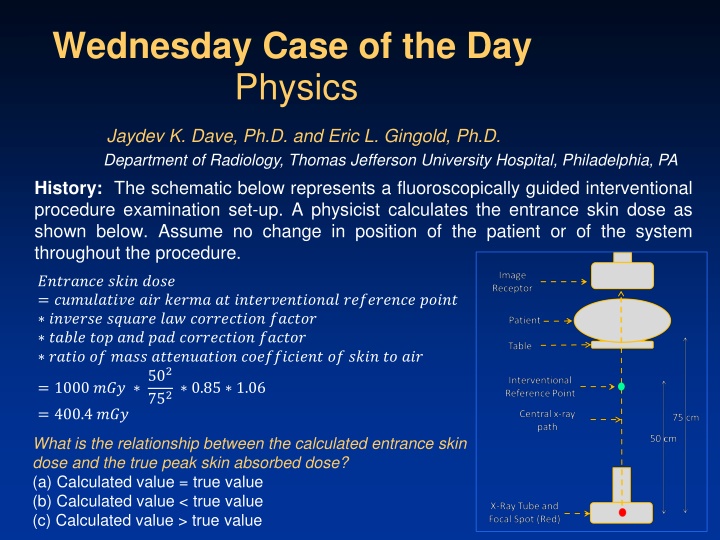
Relationship Between Calculated and True Peak Skin Doses in Radiology Procedures
Exploring the discrepancy between calculated and true peak skin doses in fluoroscopically guided interventional procedures. Backscatter factor impacts peak skin dose calculation significantly. Proper consideration and inclusion of the backscatter factor are crucial for accurate radiation dose assessment in radiology.
Uploaded on | 2 Views
Download Presentation

Please find below an Image/Link to download the presentation.
The content on the website is provided AS IS for your information and personal use only. It may not be sold, licensed, or shared on other websites without obtaining consent from the author. If you encounter any issues during the download, it is possible that the publisher has removed the file from their server.
You are allowed to download the files provided on this website for personal or commercial use, subject to the condition that they are used lawfully. All files are the property of their respective owners.
The content on the website is provided AS IS for your information and personal use only. It may not be sold, licensed, or shared on other websites without obtaining consent from the author.
E N D
Presentation Transcript
Wednesday Case of the Day Physics Jaydev K. Dave, Ph.D. and Eric L. Gingold, Ph.D. Department of Radiology, Thomas Jefferson University Hospital, Philadelphia, PA History: The schematic below represents a fluoroscopically guided interventional procedure examination set-up. A physicist calculates the entrance skin dose as shown below. Assume no change in position of the patient or of the system throughout the procedure. ???????? ???? ???? = ?????????? ??? ????? ?? ?????????????? ????????? ????? ??????? ?????? ??? ?????????? ?????? ????? ??? ??? ??? ?????????? ?????? ????? ?? ???? ??????????? ??????????? ?? ???? ?? ??? = 1000 ??? 502 752 0.85 1.06 = 400.4 ??? What is the relationship between the calculated entrance skin dose and the true peak skin absorbed dose? (a) Calculated value = true value (b) Calculated value < true value (c) Calculated value > true value
Diagnosis:The correct answer is (b), the calculated value of the entrance skin dose is less than the true value of the peak skin dose.
Discussion: The calculated value of the entrance skin dose is less than the true value of the peak skin dose because the backscatter factor has not been included in the calculations. The backscatter factor is a function of the beam quality (depending on kV, inherent and external filtration, and half value layer), radiation field size at the entrance skin surface and the patient thickness. The backscatter values may range from 1.3 to 1.6 depending on above parameters. Thus, the contribution of backscatter factor should be accounted for in the calculations of the peak skin dose. Calculated peak skin dose would therefore be, ???? ???? ???? = ?????????? ??? ????? ?? ?????????????? ????????? ????? ??????? ?????? ??? ?????????? ?????? ????? ??? ??? ??? ?????????? ?????? ????? ?? ???? ??????????? ??????????? ?? ???? ?? ??? * backscatter factor 502 752 0.85 1.06 * 1.4 = 400.4 ??? 1.4 = 560.6 ??? = 1000 ??? Note, that the contribution of the backscatter factor resulted in a 40 % increase in the calculated value of the peak skin dose.
References/Bibliography: 1. National Council on Radiation Protection and Measurements Report No. 168: Radiation dose management for fluoroscopically guided interventional medical procedures. Published in 2011. 2. Jones, AK and Pasciak AS. Calculating the peak skin dose resulting from fluoroscopically-guided interventional. Part I: Methods. Journal of applied clinical medical physics, vol 12 (4), 2011: 231-244. 3. Jones, AK and Pasciak AS. Calculating the peak skin dose resulting from fluoroscopically-guided interventional. Part II: Case Studies. Journal of applied clinical medical physics, vol. 13 (1), 2012: 174-188.
